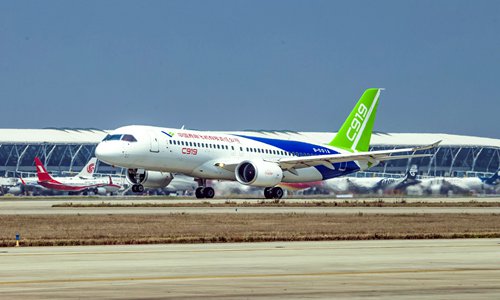From dream to reality
History of aircraft families provides road map to industry development

The COMAC C919, China's first domestically developed large passenger jet, goes through its final high-speed taxiing test on Sunday at Shanghai Pudong International Airport in Shanghai. Photo: IC
Spring may be the planting season for farmers, but this year it is the season that the world's major aircraft makers harvest what they have sown.In March and April, Airbus, Boeing and Commercial Aircraft Corp of China (COMAC) have all announced milestones that their aircraft have passed on the way to production.
On Sunday, COMAC put its C919 through a trial run on the tarmac, testing the aircraft's capabilities to take off.
The test took the jet down the runway to the point where its nose landing gear came off the ground - a crucial test to pass before an aircraft can take its maiden flight.
So far, C919 has received 570 orders from 23 customers.
Domestic media has covered every step of the C919's progress toward that flight, which has been twice delayed due to production issues. Still, the most recent reports have stated that the single-aisle passenger jet could undertake its inaugural flight at the beginning of May.
The maiden flight marks the beginning of a comprehensive sequence of test flights and diagnostics that an aircraft needs to get certified.
The C919's recent test followed news that Boeing's 737 MAX 9 had completed its maiden flight earlier in April. The 737 MAX 9 is the second member of Boeing's 737 MAX family. The narrow-body passenger jet can carry up to 220 passengers and can fly as far as 3,515 nautical miles.
A few weeks earlier at the end of March, the Airbus A319neo completed its maiden flight. The aircraft, the smallest member of Airbus' A320neo family, took off from Hamburg, Germany, and landed in Toulouse, France, after a five-hour flight.
The history of the 737 MAX and A320neo families serves as something of a road map for how to advance aircraft development.
About a decade ago, the two aerospace giants both found themselves in need of revamping their aging but popular single-aisle aircraft: the Boeing 737 and the Airbus A320.
In 2010, Airbus launched the A320neo with a new engine. Airlines applauded the new design, which received a multitude of orders. Under pressure from Airbus' new aircraft, Boeing responded the following year with its 737 MAX program. Boeing promoted the new design as being more fuel efficient than the A320neo. Airbus has received more than 5,000 A320neo orders from more than 90 customers.
The first 737 MAX 8 came off the production line at the end of 2015.
In March, US-based Boeing announced that US Federal Aviation Administration had certified the 737 MAX 8 for commercial use. The company is now in the final stage of preparing for the first 737 MAX 8 deliveries in the second quarter of this year, several months ahead of schedule.
Although the first 737 MAX came out a year later than the first A320neo, the Boeing jet was still a hit with customers. Boeing has received more than 3,700 orders from 86 customers worldwide for the aircraft, making it the fastest-selling plane in Boeing's history.
Boeing also said it will have more Boeing 737 MAX aircraft coming out of its factory in Zhoushan, East China's Zhejiang Province.
Despite Boeing's success with the 737 MAX, Airbus has managed to take a big share of the market for single-aisle passenger jets with its A320neo family. Airbus has called the aircraft family the world's best-selling single-aisle product line.
Airbus' commercial aircraft deliveries rose for the 14th year in a row in 2016, when the company delivered 688 aircraft to 82 customers, beating its previous record of 635 aircraft set in 2015.
Airbus' aircraft deliveries rose 8 percent in 2016, when it delivered 545 jets in the A320 family, including 68 A320neos. More than 40 percent of Airbus' single-aisle aircraft deliveries were the larger A321 models. The company also delivered 66 A330s, 49 A350 XWBs and 28 A380s.
In the latest aircraft delivery news on Monday, South Korea's Asiana Airlines has taken delivery of its first A350-900, becoming the 12th airline in the world to operate the twin-engine, wide-body plane. Boeing is already considering creating an extended model of the 737 MAX that will have more seats, but with lower costs.
As Boeing and Airbus continue to create more innovative and technologically advanced aircraft, China cannot let itself fall behind in the competition.
Although senior executives from Boeing and Airbus have said on different occasions that they welcome the competition of the C919, its launch will break their decades-long duopoly on the single-aisle passenger jet market.
The C919 is expected to have a successful inaugural flight, but the flight remains only the first step in a long march. One might argue that it is unfair to compare COMAC with Boeing or Airbus because the companies are at different stages of development. Still, sales volume is the only way to determine whether a model is popular among customers.

